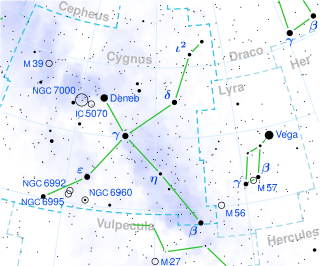
Albireo is a double star designated Beta Cygni. The International Astronomical Union uses the name "Albireo" specifically for the brightest star in the system. Although designated 'beta', it is fainter than Gamma Cygni, Delta Cygni, and Epsilon Cygni and is the fifth-brightest point of light in the constellation of Cygnus. Appearing to the naked eye to be a single star of magnitude 3, viewing through even a low-magnification telescope resolves it into its two components. The brighter yellow star, itself a very close binary system, makes a striking colour contrast with its fainter blue companion.

16 Cygni or 16 Cyg is a triple star system approximately 69 light-years away from Earth in the constellation of Cygnus. It consists of two Sun-like yellow dwarf stars, 16 Cygni A and 16 Cygni B, together with a red dwarf, 16 Cygni C. In 1996 an extrasolar planet was discovered in an eccentric orbit around 16 Cygni B.

V1500 Cygni or Nova Cygni 1975 was a bright nova occurring in 1975 in the constellation Cygnus. It had the second highest intrinsic brightness of any nova of the 20th century, exceeded only by CP Puppis in 1942.

Zeta Cygni is a binary star system in the northern constellation of Cygnus, the swan. It has an apparent visual magnitude of 3.26 and, based upon parallax measurements, is about 143 light-years away.

V373 Cas is a binary star system in the northern constellation Cassiopeia. It is a suspected eclipsing binary with an apparent visual magnitude that decreases from a baseline of 6.03 down to 6.13. The system is located at a distance of approximately 6,200 light years from the Sun, but is drifting closer with a radial velocity of around −25.5 km/s.

32 Cygni is a binary star system in the Cygnus constellation. It is a 4th magnitude star, which can be seen with the naked eye under suitably dark skies. Parallax measurements give an estimated distance of 1,000 light-years (307 parsecs) from the Earth. However, Schröder et al. (2007) suggest the actual value, after correcting for Malmquist bias, may be closer to 1,174 light-years (360 parsecs). Although it is a spectrsocopic binary with components that cannot be separated visually, it has two entries in the Henry Draper Catalogue, with identical magnitudes and positions, but showing the spectral types of the two components.
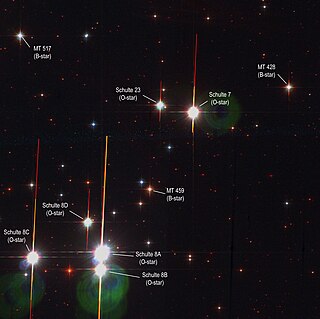
Cygnus OB2 #8A is a double-lined spectroscopic binary located near the centre of the Cygnus OB2 association located 5,500 light years away.

ξ Cygni is a spectroscopic binary star in the constellation Cygnus, made up of a K-type supergiant star (primary) and an A-type star (secondary). Its apparent magnitude is 3.73, making it readily visible to the naked eye, and it is located around 350 parsecs (1,100 ly) away.
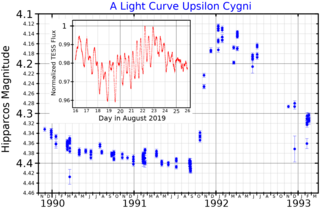
Upsilon Cygni, Latinized from υ Cygni, is a star in the northern constellation of Cygnus. It is visible to the naked eye, having an apparent visual magnitude of 4.43. Based upon an annual parallax shift of 5.0 mas, it lies at a distance of roughly 650 light years from the Sun.
57 Cygni is a close binary star system in the constellation Cygnus, located about 530 light years from Earth. It is visible to the naked eye as a blue-white hued star with a baseline apparent visual magnitude of 4.80. The pair have a magnitude difference of 0.34. This system is moving closer to the Earth with a heliocentric radial velocity of −21 km/s.

31 Cygni, also known as ο1 Cygni, Omicron1 Cygni, ο2 Cygni or V695 Cygni, is a ternary star system about 750 light years away in the constellation Cygnus.
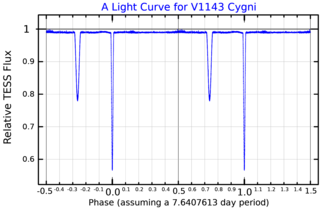
HR 7484 is a binary star system in the northern constellation of Cygnus. It is dimly visible to the naked eye under good viewing conditions, having an apparent visual magnitude of 5.89. Based upon an annual parallax shift of 24.71, it is located 132 light years away. The system is moving closer with a heliocentric radial velocity of −14 km/s.
9 Cygni is a binary star system in the northern constellation of Cygnus. 9 Cygni is its Flamsteed designation. The two stars have a combined magnitude of 5.39, so it can be seen with the naked eye under good viewing conditions. Parallax measurements made by Gaia put the star at a distance of around 590 light-years away.

RR Lyncis is a star system in the northern constellation of Lynx, abbreviated RR Lyn. It is an eclipsing binary of the Algol type; one of the closest in the northern sky at an estimated distance of approximately 263 light years based on parallax measurements. The system is faintly visible to the naked eye with a combined apparent visual magnitude of 5.53. During the primary eclipse the brightness drops to 6.03, while it decreases to magnitude 5.90 with the secondary eclipse. The system is drifting closer to the Sun with a radial velocity of −12 km/s.
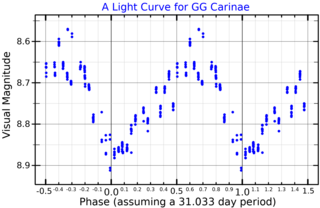
GG Carinae is a binary star system in the southern constellation of Carina, abbreviated GG Car. It is a variable star with a brightness that fluctuates around an apparent visual magnitude of 8.67, making it too faint to be visible to the naked eye. The distance to this system is approximately 8,000 light years based on parallax measurements.
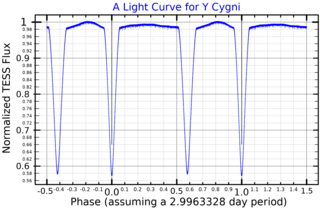
Y Cygni is an eclipsing and double-lined spectroscopic binary star system in the constellation of Cygnus. It is located about 4,900 light-years from Earth. The system was one of the first binaries with a convincing detection of the apsidal precession.

SU Cygni is a triple star system in the northern constellation of Cygnus, abbreviated SU Cyg. The primary component of the system is a classical Cepheid variable with a period of 3.8455473 days. The changing luminosity of this star causes the system to vary in brightness from a peak apparent visual magnitude of 6.44 down to magnitude 7.22 over the course of its cycle. The distance to this system is approximately 3,200 light years based on parallax measurements. It is a member of the Turner 9 open cluster of stars.

HD 224355, also known as V1022 Cassiopeiae, HR 9059 and Boss 6148, is an eclipsing binary star in the constellation Cassiopeia. It ranges in apparent magnitude from 5.57 to 5.68, which means it is faintly visible to the naked eye for an observer located well away from city lights. It is one of the few binaries known to be an astrometric, spectroscopic and eclipsing binary, a combination that allows the parameters of the stellar system to be calculated with high accuracy. HD 224355 lies 16′ west of the 5th-magnitude σ Cassiopeiae.

V389 Cygni, also known as HD 201433 and HR 8094, is a star about 390 light years from the Earth, in the constellation Cygnus. It is a 5th-magnitude star, making it faintly visible to the naked eye of an observer far from city lights. V389 Cygni is a multiple star. One component of that system is a slowly pulsating B-type star (SPB) causing the system's brightness to vary from magnitude 5.55 to 5.71 over a period of 1.4 days.

HD 159176, also known as Boss 4444 and V1036 Scorpii, is a variable star about 2,800 light years from the Earth, in the constellation Scorpius. It is a 5th magnitude star, so it should be visible to the naked eye of an observer far from city lights. HD 159176 is the brightest star in the young open cluster NGC 6383. It is a binary star composed of two nearly identical O stars in a circular orbit.













